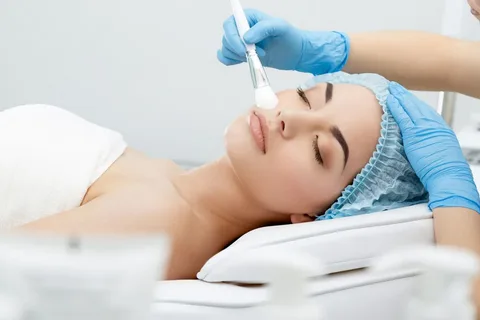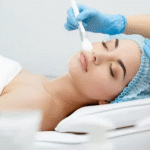Acne scars can linger long after the blemishes have faded, affecting your self-esteem and overall appearance. One of the most effective non-surgical treatments for reducing the appearance of these scars is a chemical peel. These treatments offer a non-invasive way to improve skin tone, texture, and clarity—especially for those struggling with the long-term effects of acne.
What Are Chemical Peels?
Chemical peels are cosmetic procedures that use a chemical solution to exfoliate and remove the damaged outer layers of the skin. Depending on the severity of the skin concern, peels can be light, medium, or deep. For acne scars, medium-depth peels are most commonly used, targeting both surface pigmentation and deeper textural issues.
Chemical Peels التقشير الكيميائي, have gained popularity among individuals seeking smoother, clearer skin. This procedure helps remove the top layers of the skin where scarring and imperfections tend to reside, making it a viable option for those looking to renew their complexion without surgical intervention.
How Chemical Peels Improve Acne Scars
Chemical peels improve acne scars in several ways:
-
Exfoliation: The solution removes the damaged outer skin layers, revealing fresh, healthier skin beneath.
-
Collagen Production: As the skin heals post-peel, collagen production is stimulated, which helps fill in indented scars and improves elasticity.
-
Even Skin Tone: Pigmentation issues, such as post-inflammatory hyperpigmentation, are reduced with regular treatment.
-
Smoother Texture: Over time, repeated peels lead to a smoother and more even skin surface.
Types of Peels Suitable for Acne Scars
-
Glycolic Acid Peels: Good for superficial scars and uneven tone.
-
Salicylic Acid Peels: Best for oily and acne-prone skin.
-
TCA (Trichloroacetic Acid) Peels: Penetrates deeper, ideal for more pronounced scarring.
-
Jessner’s Peel: A combination peel effective for moderate scarring and pigmentation.
What to Expect During the Procedure
The process begins with a thorough cleansing of the skin. The chemical solution is then applied to the face and left on for a specific period, depending on the type and strength of the peel. You may feel a tingling or burning sensation, which typically subsides shortly after the procedure.
After the peel, the skin may appear red and start to flake or peel over the next several days. It’s essential to follow post-procedure care instructions, including sun protection and moisturization.
Downtime and Recovery
-
Light Peels: Minimal to no downtime; slight redness may occur.
-
Medium Peels: 5-7 days of peeling and flaking.
-
Deep Peels: Up to two weeks of recovery, often requiring medical supervision.
Results and Frequency
While you may notice improvements after a single session, a series of treatments is usually recommended for best results. Most clients see optimal changes in their skin texture and tone after 3–6 treatments spaced a few weeks apart.
Who Is a Good Candidate?
Chemical peels are suitable for most skin types, though a professional consultation is necessary to determine the right type and strength of peel for your specific acne scars and skin tone. Individuals with active acne or very sensitive skin may need to treat inflammation first before undergoing a peel.
Benefits Beyond Scar Reduction
Besides addressing acne scars, chemical peels can also help with:
-
Enlarged pores
-
Sun damage
-
Fine lines
-
Dull skin tone
-
Uneven texture
This makes them a comprehensive solution for overall skin rejuvenation.
Pre-Treatment Tips
-
Avoid retinoids and exfoliating agents at least 48 hours prior.
-
Limit sun exposure in the week leading up to your peel.
-
Inform your provider of any medications or skin conditions.
Post-Treatment Care
-
Use a gentle cleanser and rich moisturizer.
-
Apply sunscreen religiously to avoid hyperpigmentation.
-
Avoid picking at flaking skin to prevent scarring.
-
Skip harsh skincare for a few days after the treatment.
Professional vs. At-Home Peels
While at-home peels offer convenience, professional peels deliver deeper and more controlled results, especially for treating acne scars. Always consult a licensed dermatologist or aesthetician for more potent chemical peels to ensure safety and efficacy.
Cost of Chemical Peels for Acne Scars
Prices vary depending on the type of peel and the clinic location. On average:
-
Light Peels: $80–$150 per session
-
Medium Peels: $200–$500 per session
-
Deep Peels: $600–$1000+ per session
Packages often come at discounted rates and can make multiple treatments more affordable.
Conclusion
Chemical peels provide a proven, non-invasive way to reduce acne scars and improve skin clarity and texture. With a wide range of options tailored to different skin types and conditions, they remain a reliable solution for those seeking to renew their complexion and regain confidence. Whether you’re looking for a mild refresh or a deeper rejuvenation, chemical peels offer a customizable path to clearer, smoother skin.








0 Comments